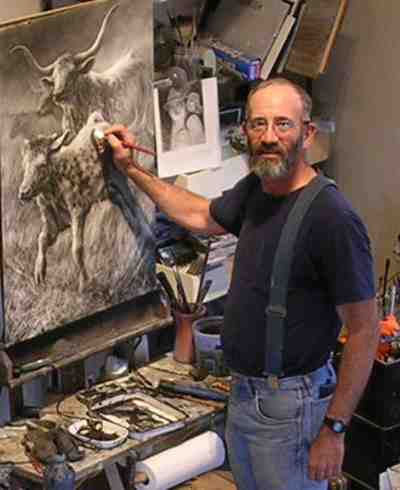Article by Marcia Darnell
Local Artist – November 2007 – Colorado Central Magazine
CHARLES EWING has the life. Now 60, he’s been a working (and selling) artist most of his adult life. He lives on a beautiful patch of earth, surrounded by the rolling hills and gentle mesas of Conejos County, in a large, comfortable home he’s renovated himself. He’s an inventor, sculptor, painter, and all-around creator.
And it’s all thanks to being a rebel.
“My father, Frank, was a technical artist and weekend fine artist,” Ewing recalls. “He always discouraged me from going into it.”

Ewing’s father raised him in New Mexico, but they spent a lot of time in the San Luis Valley.
“My grandfather used to come up here in the ’30s and my father got hooked on it for fishing trips and vacations.”
Ewing moved from Cimarron, N.M., to Conejos in 1976. He ran an outfitting business for a few years near the Conejos River, then lost his home in a fire. He made the move to the Manassa area in 1981.
Ewing dabbled in art during his childhood, then, motivated by his father to find another business, went to CSU to study wood technology. His father died while he was in college, but Ewing finished his B.S. and then joined the Peace Corps.
“I was working at the University of Chile building better fruit containers for exporting when Allende came to power and the university closed,” he says. “In the meantime I’d been taking some art classes from Tom Daskam, an American artist who settled there.”
The revolution left him with two choices. “I either had to go home or into another job with the Peace Corps,” he remembers.
Through the Peace Corps, Ewing met a group of biologists who’d been hired to catalogue the mammals of Chile. They hired him to illustrate what became a book about the animals, and he spent a year traveling, camping and sketching all over the country.
“They ended up colorizing my black-and-white drawings and they looked like hell, but my name was on it,” he says of the resulting book.
By the end of his second hitch in the Peace Corps the political situation in Chile was worsening, so he left. He wound up at the University of Washington for two years, then went back to New Mexico. He’s been supporting himself primarily as an artist ever since.
“I don’t specialize in anything,” he says. Ewing is known largely as a wildlife artist, but also does portraits, plein-aire landscapes, and is “getting into sculpture.”
His special pride is his material invention — India ink on porcelain clay. He invented the form, and he and his wife, Barbara, started Ampersand Art Supply. Located in Austin, the company manufactures the clay board used for the art form. The business is run by Elaine Salazar, sister of Rep. John and Sen. Ken Salazar.
In addition to his two patents, Ewing holds the copyright to a book, The New Scratchboard, which he authored about the technique.
He paints often, hiring models from Adams State College’s art department and sometimes from the communities around him. Ewing travels frequently to Mexico and Europe and takes a lot of photographs of the faces he sees to paint later. Of course, he’s best known for his wildlife art, which he draws from the animals he sees on his travels and around his home.

He takes inspiration from everything around him, he says.
“Whatever holds interest for you will usually make a good painting,” he says. “Inspiration to me is a quiet little thing called ‘interest.’ It doesn’t have to be flamboyant.”
Despite his international reputation and solid sales history, Ewing insists he’s still learning.
“There’s always growth happening,” he says. “I’ll be learning when I die. What you don’t know expands at a greater rate than what you master, which makes for an interesting life. You’re always challenged.”
Ewing says he drives gallery owners nuts with his constant experimentation and changes. They like constancy and predictability, and he likes to try new things.
“My ideal of an artist is always changing and learning and staying interested.”
That philosophy has led him to the cruising altitude he now enjoys, with his home, dogs, and art.
“It takes a lot of patience and tenacity plus putting yourself in a low overhead situation so you can ride out the financial difficulties,” he says of an artist’s life.
His form of cheap living involved buying a old four-room house and renovating it himself. The house, dating from 1889, is still a work in progress, featuring exposed beams, lots of adobe, brick floors, and Moorish archways. Ewing added a studio with big, big north windows and a “double barrel” wood stove coated with adobe that’s so efficient he only needs to stoke it every other day in the winter. He’s still working on another bathroom, a kitchenette, an office, and an area for framing his paintings.
His home improvements, he says, are another form of creativity. So is his movable easel, his own invention. The frame holds a painting of any size and allows him to move the work up, down, or to either side to make working on it easier.
Ewing modestly downplays his art and inventions, believing creativity is inherent in all of us. “Creativity isn’t rare,” he says. “Every decision a person makes is a form of creativity. The process isn’t limited to artists. It goes on a thousand times a day in everyone’s life.”
Marcia Darnell lives, writes, and savors touring artists’ studios in the San Luis Valley.
Charles Ewing’s work can be seen and purchased at Walden Fine Arts in Taos; Justin Roberts Gallery in Santa Fé; Battle Mountain Trading Company in Minturn; and Wild Spirit Gallery in Pagosa Springs. His stuff is also on the web, at www.CharlesEwing.com.

